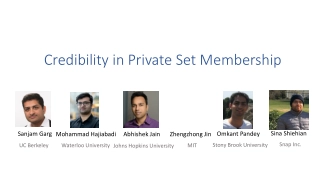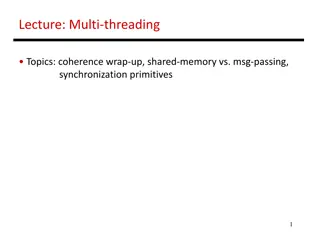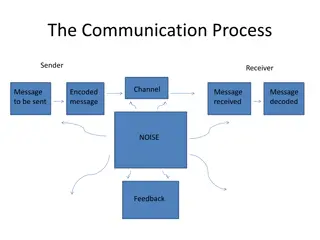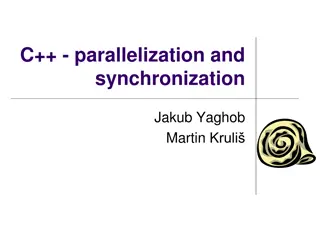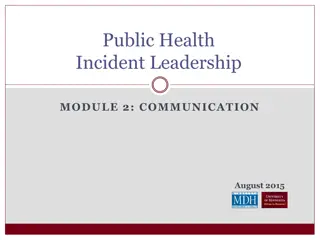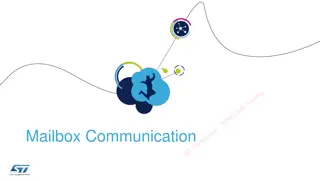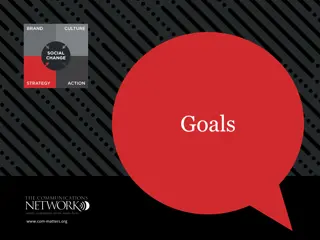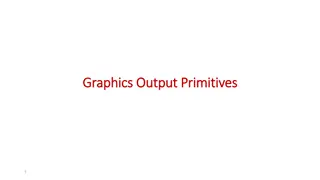Domain-Agnostic Information Model for Vehicle Data Transformation
The push towards a domain-agnostic information model from a vehicle-centric data approach is explored due to emerging industry requirements. COVESA projects like AUTOSAR Vehicle API and EV charging necessitate a shift. The proposal introduces the Hierarchical Information Model (HIM) to organize data
0 views • 10 slides
Ensuring Credible Private Set Membership with Efficient Communication
Explore the concept of credible private set membership ensuring server privacy, client privacy, and data credibility through innovative protocols and approaches. The focus is on maintaining high-entropy passwords securely while optimizing rounds and leveraging underlying crypto primitives efficientl
1 views • 18 slides
Mastering Business Writing Skills: A Comprehensive Guide
Understanding the essence of business communication, types of communication, essentials of effective communication, smart communication tips, and communication across cultures is vital for professional success. Explore verbal, written, and non-verbal communication methods to enhance your communicati
0 views • 47 slides
Understanding Communication and Sign Language
Communication is the vital process of exchanging information, ideas, and emotions through various channels such as speech, signals, and writing. This includes verbal and non-verbal communication, where sign language plays a crucial role. Effective communication depends on the sender, message, channe
1 views • 31 slides
Enhancing Zoonotic Disease Risk Communication in Public Health Emergencies
Explore the significance of adopting a One Health approach to zoonotic disease risk assessment and communication in the context of emergency health situations. The session emphasizes core capacities required by the International Health Regulations (IHR) 2005, effective risk communication processes,
2 views • 13 slides
Effective Communication Skills for Healthcare Professionals
Enhance your communication skills with the Accelerated Preceptorship Communication Session by Desiree Cox. Learn the importance of effective communication, different communication preferences, communication dynamics, non-verbal communication, listening skills, and more. Understand the communication
2 views • 28 slides
Distributed Computation in Node-Capacitated Networks
Exploration of communication primitives and algorithms in node-capacitated networks, including Node-Capacitated Clique Model, communication on butterfly networks, orientation using Boruvka's algorithm, computing O(a)-orientation, and solving graph problems like BFS trees, maximal independent set, ma
0 views • 7 slides
Understanding Multi-Threading Concepts in Computer Systems
Exploring topics such as cache coherence, shared memory versus message passing, synchronization primitives, cache block states, performance improvements in multiprocessors, and the Ocean Kernel procedure for solving matrices.
0 views • 22 slides
APL - A Functional Language with Array Paradigms
APL, named after the book "A Programming Language Paradigms," is a functional language with a focus on array manipulation. Developed in the 1960s by Kenneth E. Iverson, it has had a significant impact on the development of spreadsheets and computer math packages. APL operates with chains of monadic
0 views • 11 slides
Understanding Provable Security Models in Cryptography
Cryptography and cryptology involve secure communication techniques to protect data from third-party adversaries. This article introduces provable security models, cryptographic goals like confidentiality and authenticity, and the approach of security by trial-and-error versus provable security meth
0 views • 48 slides
Understanding Small-State Noncryptographic Pseudorandom Number Generators
Explore the design and testing of small-state noncryptographic pseudorandom number generators, including definitions, rules of thumb, chisquare tests, existing and new generators, and more. Learn about block cipher encryption, hash functions, pseudorandom number generation, reversible mixing, and re
0 views • 46 slides
Effective Communication Strategies in Business Environments
Explore the various aspects of communication processes within organizations, including sender-receiver dynamics, communication channels, small group networks, upward and downward communication methods, business communication tools, information richness of channels, email and voice mail etiquette, an
0 views • 21 slides
Robust Parity Test for Extracting Parallel Vectors in 3D
Fundamental primitives for visualizing 3D data include line features like ridges and valleys of a scalar field, stream lines of a vector field, vortices of a velocity field, and extremal curves of a tensor field. Parallel Vectors (PV) provide a unified representation of 3D line features, forming con
0 views • 27 slides
Understanding C++ Parallelization and Synchronization
Explore the challenges of race conditions in C++ multithreading, from basic demonstrations to advanced scenarios. Delve into C++11 features like atomic operations, memory ordering, and synchronization primitives to create efficient and thread-safe applications.
0 views • 51 slides
Portable Inter-workgroup Barrier Synchronisation for GPUs
This presentation discusses the implementation of portable inter-workgroup barrier synchronisation for GPUs, focusing on barriers provided as primitives, GPU programming threads and memory management, and challenges such as scheduling and memory consistency. Experimental results and occupancy-bound
0 views • 61 slides
Understanding Classroom Communication and Management by Ramkrishna Chakraborty
Communication is a vital process of exchanging information, ideas, and opinions between individuals. In the educational context, effective communication is essential for achieving desired behavior patterns. This article explores the meaning, concept, and types of communication, emphasizing the impor
1 views • 19 slides
Understanding Graphics Pipeline Clipping Techniques
Delve into the intricate process of graphics pipeline clipping in computer graphics, from breaking primitives into fragments to determining visible parts for rendering. Explore the necessity of clipping, culling, and endpoint conditions, as well as techniques like Cohen-Sutherland Line Clipping. Gai
0 views • 18 slides
Understanding Advanced Graphics and UIs Rendering Pipeline
Explore the intricate details of the rendering pipeline in advanced graphics and user interfaces, including clipping and culling processes. Learn about the sequence of operations involved in drawing primitives, the evolution of APIs like OpenGL and D3D, and the various stages from vertices to visibl
0 views • 52 slides
Understanding Weird Machines in Transient Execution
Weird machines refer to models exhibiting unintentional behaviors triggered by adversarial inputs. They serve as computation primitives, enabling tasks like program obfuscation and secret computations. TSX weird machines, computing with time, manipulate cache states through gates like Assign, AND, O
0 views • 18 slides
Effective Communication Strategies in Public Health Incident Leadership
Learn about the importance of effective communication within emergency operations centers during public health incidents. Explore communication tools, techniques, and case examples of communication failures. Discover key aspects such as team communication, situational awareness, shared mental models
0 views • 16 slides
Communication Protocols for System Integration
This technical document explores various communication protocols used for system integration, focusing on mailbox communication, interprocessor communication, system communication using IPCC, and BLE communication utilizing different IPCC channels. The document delves into the features, functions, a
1 views • 6 slides
Effective Communication Skills in Business Environment
Understand the importance of communication in organizations, learn about the process of communication, main objectives, types, and patterns of communication. Explore key points such as accuracy in conveying ideas, feedback, and communication channels. Enhance your knowledge on downward, upward, and
0 views • 24 slides
Mastering Effective Communication Skills in Daily Life
Enhance your communication skills with insights from Unit 5 Communication. Learn about different types of communication, speaking skills, effective communication strategies, assertiveness, and more. Understand the nuances of verbal, nonverbal, and paralanguage communication to convey your message cl
0 views • 52 slides
Understanding C++ Parallelization and Synchronization Techniques
Explore the challenges of race conditions in parallel programming, learn how to handle shared states in separate threads, and discover advanced synchronization methods in C++. Delve into features from C++11 to C++20, including atomic operations, synchronization primitives, and coordination types. Un
0 views • 48 slides
Communication Lower Bounds of Key-Agreement Protocols
Key-agreement protocols play a vital role in secure communication between parties. This document explores lower bounds of key-agreement protocols through density increment arguments, idealization of symmetric primitives, Merkle puzzles, and the impact of communication bits between Alice and Bob. Var
0 views • 10 slides
Understanding Fill Area Primitives in Computer Graphics
An overview of fill area primitives in computer graphics, including the concept of fill areas, polygon fill areas, and polygon classifications into convex and concave polygons. This module covers the efficient processing of polygons, approximating curved surfaces, and generating wire-frame views of
0 views • 63 slides
Understanding Attributes and Color Schemes in Graphics
Graphics systems utilize attributes to define how primitives are displayed, such as color and size, while color and grayscale can be stored in different ways like direct storage and indexed storage schemes. The RGB color components play a key role in determining the color shades, with various color
0 views • 51 slides
Geometric Pipeline Implementation Strategies: From Vertices to Fragments
The chapter delves into the process of converting vertices into primitives, clipping out objects outside the view frustum, and determining affected pixels by each primitive. Tasks such as rasterization, transformations, hidden surface removal, and antialiasing are discussed. Various algorithms for c
0 views • 68 slides
Understanding the Composite Design Pattern in Object-Oriented Programming
The Composite design pattern allows clients to treat individual objects and compositions of objects uniformly, enabling the representation of part-whole hierarchies in tree structures. This pattern is commonly used in graphics applications to create complex diagrams from simple components, allowing
0 views • 43 slides
Clear Approach to Cancellation of Asynchronous Operations
This resource discusses the concept of cancellation primitives, providing a clear and consistent approach to cancelling asynchronous operations. It emphasizes separating the source and sink, enabling synchronous and asynchronous observation of cancellation requests. The goal is to facilitate composa
0 views • 17 slides
Effective Communication in Workplace Safety Training
This presentation covers the importance of effective communication in workplace safety training, emphasizing the elements of a communication plan, communication processes, and the realities of communication. It explores the consequences of failure to communicate safety information effectively and di
1 views • 31 slides
Communication Costs in Distributed Sparse Tensor Factorization on Multi-GPU Systems
This research paper presented an evaluation of communication costs for distributed sparse tensor factorization on multi-GPU systems. It discussed the background of tensors, tensor factorization methods like CP-ALS, and communication requirements in RefacTo. The motivation highlighted the dominance o
0 views • 34 slides
Cryptography in Bounded Storage Model: Ensuring Secure Communication
Cryptography in the Bounded Storage Model provides insights into securing communication with secrecy and authenticity. The model limits adversaries' memory without runtime restrictions, ensuring unconditional security for various primitives. Explore how this model safeguards messages from eavesdropp
0 views • 42 slides
Strategic Communication Goals and Objectives
Clearly defining goals and objectives is essential in strategic communication. This involves setting realistic and aligned targets, such as building communication capacity, influencing policy, and engaging public will. Communication plays a crucial role in achieving social change and programmatic su
0 views • 67 slides
Embedded Systems: Introduction to Input and Output Devices
This material explores the essential concepts related to input and output (I/O) devices in embedded systems. It covers examples of I/O devices, such as keyboards, mice, and disk drives, along with the digital interface between these devices and the CPU. Specific focus is given to the 8251 UART as an
0 views • 55 slides
Understanding Scala's Class Hierarchy and Value Classes
Scala's class hierarchy includes Any, AnyVal, and AnyRef classes, with implicit conversions and implementations of primitives similar to Java. Learn about defining value classes, natural and reference equality comparisons, and more in Scala programming.
0 views • 24 slides
Understanding Remote Procedure Calls in Distributed Systems
Explore the concept of Remote Procedure Calls (RPC) in distributed systems, including the basic RPC approach, middleware layers, transport primitives, failure types, and more. Learn how RPC enables communication between sender and receiver seamlessly, without direct message passing visible to the pr
0 views • 19 slides
Specialization in International Business Communication (SIBC)
Specialization in International Business Communication (SIBC) offered by the Department of Business Communication focuses on the critical role of communication in various business settings, emphasizing skills in language usage, communicative competence, and strategic language application. The progra
0 views • 11 slides
Understanding Graphics Output Primitives and Coordinate Reference Frames
Graphics output primitives and coordinate reference frames play a crucial role in describing scenes and drawing basic geometric structures in 2D space. These concepts involve defining points, drawing lines, and understanding pixel coordinates within a coordinate system. Absolute and relative coordin
1 views • 35 slides
New Assumptions for Achieving Chosen Ciphertext Security in Cryptography
This research work focuses on presenting new assumptions for achieving chosen ciphertext security in public key encryption. The study aims to clarify the necessary and sufficient assumptions to realize general cryptographic primitives, particularly focusing on CCA secure PKE and KEM. The ultimate go
0 views • 27 slides

